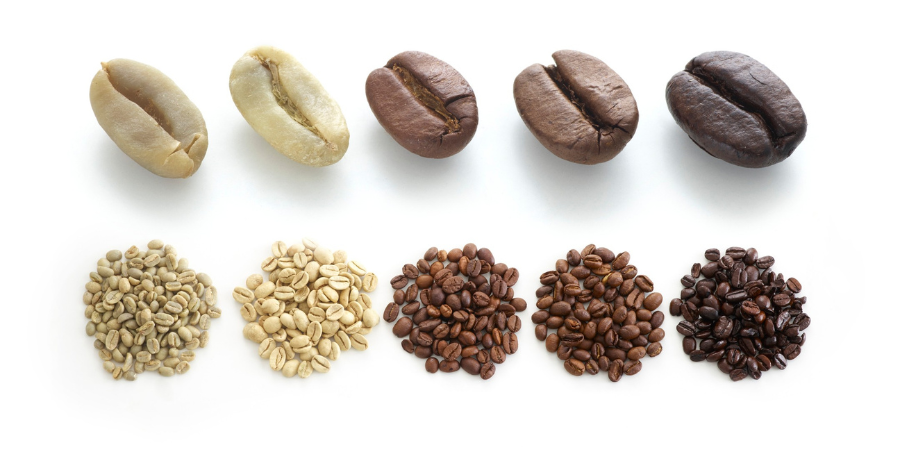
Roast Levels and Coffee Flavors
Share
Two of the most common questions I get asked as a specialty coffee roaster are:
-
“What differentiates light, medium, and dark roasts?”
-
“How does coffee gets its flavor?”
First, let’s discuss the different roast levels...
Roasts are most commonly referred to as “light,” “medium,” and “dark.” These levels are on a spectrum and are determined by time and temperature. The easiest way to determine the roast level of a bean is by its color-- light brown for a light roast, dark brown for medium roast, and black for a dark roast. Exact times and temperatures depend on the roasting machine and the particular coffee. The following is an example of common parameters for roast levels on my drum roaster:
- Light roasts will be dumped when the inside of the roaster reaches 400-406 degrees in 9-9:30 minutes.
- Medium roasts will be dumped at 410-420 degrees in 10-11 minutes.
- Dark roasts will be dumped at 435-445 degrees in 11-12 minutes.
Next, let’s discuss coffee flavors or “tasting notes.” Like quality wines, all specialty coffees contain delicious flavors. The number one job of a good coffee roaster is to accentuate those delicious natural flavors-- a task that is both an art and a science, and takes A LOT of practice!
So how does a coffee roaster decide on the roast level for a particular coffee? The answer is based on the particular tasting notes that the roaster wants to highlight. For example, an Ethiopian coffee that has bright fruity notes will almost always taste best as a light roast. A chocolatey Honduran coffee will taste great as a medium roast. And a Brazil coffee with nutty and dark chocolate notes with low acidity will perform well at a dark roast.
Experienced roasters always allow the coffee to determine the proper roast level, which means before roasting the coffee they evaluate many different factors about the coffee in order to accentuate the delicious natural flavors hiding inside the bean.
As mentioned before, light roasts are best applied to coffees that have bright, fruity, or floral notes. This is often the case with African coffees, as well as some from Central and South America. Light roasts typically have a lighter body to them, similar to hot tea. They also have the highest acidity, which is a “brightness” you feel on your palette. Light roasts have become extremely popular over the past decade or so, as flavors in coffee continue to improve as coffee quality evolves. The Third Wave Coffee movement has created an increase in the popularity of light roasts.
Medium roasts work well with beans that have chocolatey, earthy, or nutty flavors. Medium roasts have a thicker body than light roasts, delivering a fuller "mouthfeel," as its called. Think of the how thick milk feels in your mouth compared to hot tea. Roasting a coffee to medium tones down the acidity, which is highest in a light roast. Medium roasts are probably most popular right now and are easiest for most coffee drinkers to enjoy. They make nice blends and crowd-pleaser coffees for cafes, restaurants, etc.
Dark roasts were most popular before coffee quality evolved to the high standard it has now achieved. Before quality and roasting experience skyrocketed, roasters predominately roasted to dark to mask any flaws or undesirable flavors. A dark roast tastes burnt and smoky because the bean is actually beginning to burn. A lighter dark roast will still carry some of the beans natural flavors, but the flavors will be toned down.
In summary, I want to bring clarity to a topic of common confusion. After being in the coffee industry for many years, I often hear folks say they like dark roasts because they enjoy “strong” coffee. After many conversations with coffee drinkers, I have realized that most who say they like "strong" coffee are under the assumption that light or medium roasts are weak in flavor, dark roasts being superior because they provide the most flavors.
Now, this could be the case for stale or poor quality coffee, but not with freshly roasted, specialty coffee. Typically, light and medium roasts bring out the fullest natural flavors from the bean. I believe Starbucks has contributed mostly to this confusion as they predominantly served dark roasts in their company’s early days. Starbucks became so popular in the coffee world that they literally defined how people thought coffee should taste.
I hope this blogpost has given you a better understanding and appreciation of coffee. This article barely even scratches the surface of speciality coffee!
Thanks for reading and happy drinking! :)
